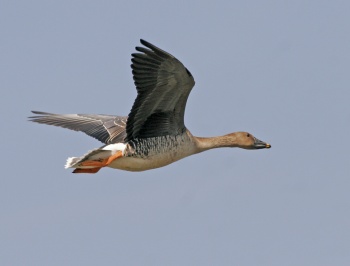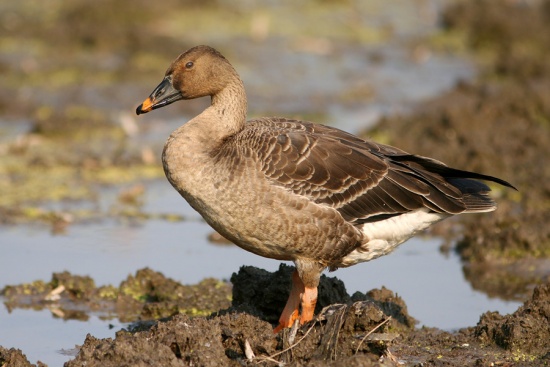m (→Taxonomy) |
|||
| Line 33: | Line 33: | ||
*''A.f. johanseni'' -- northern forest zone (taiga) east of the Urals to Lake Baikal (often included in the following by other authorities) | *''A.f. johanseni'' -- northern forest zone (taiga) east of the Urals to Lake Baikal (often included in the following by other authorities) | ||
*''A.f. middendorffii'' -- northern forest zone (taiga) east of ''johanseni'' | *''A.f. middendorffii'' -- northern forest zone (taiga) east of ''johanseni'' | ||
| − | + | Has long been considered conspecific with [[Tundra Bean Goose]] and named Bean Goose, ''Anser fabalis''.<br /> | |
In the past, [[Pink-footed Goose]] was included in Bean Goose. | In the past, [[Pink-footed Goose]] was included in Bean Goose. | ||
Revision as of 18:45, 4 January 2011
- Anser fabalis
Includes Middendorff's Goose
Identification
Taiga form (fabilis)
- Dark goose with a long neck
- Head, neck, and back are dark brownish
- Lightest on the back
- Underside is lighter
- Bill is quite long
- Very variable with regards to extent of black and orange
- Orange often found on the distal part and almost always more extensive than in the Tundra form
- May be a narrow white edge between bill and feathers on the head, especially above the bill.
In flight, tail pattern is conspicuous: narrow white terminal band, broader black band, and the innermost part white. Belly is white. Both upper and lower sides of wings are dark, without much contrast between coverts and primaries/secondaries.
Middendorff's Goose

Photo by Peter de Haas
Upo wetland Korea, February 2007 (click on image for larger version)
The subspecies middendorffii has recently been proposed for splitting from this species.
- Bill is much larger than the other two, often looking like a direct continuation of the crown.
- Longest neck
Juvenile forms are more scaly on the back and lack the white at the base of the bill.
Similar species
Tundra Bean Goose is similar but has a shorter and heavier neck, a shorter bill, rarely more than a small orange spot near the tip of the bill which is always sharply defined.
Distribution
Taiga of Scandinavia east to Russia and Siberia (east of Lake Baikal).
Both species of Bean Goose occur in Europe in winter, with northernmost flocks almost exclusively belonging to the Taiga form. A small population regularly winter in the Falkirk area of Scotland.
Taxonomy
Three subspecies are recognized[1]:
- A.f. fabilis -- northern forest zone (taiga) west of the Urals
- A.f. johanseni -- northern forest zone (taiga) east of the Urals to Lake Baikal (often included in the following by other authorities)
- A.f. middendorffii -- northern forest zone (taiga) east of johanseni
Has long been considered conspecific with Tundra Bean Goose and named Bean Goose, Anser fabalis.
In the past, Pink-footed Goose was included in Bean Goose.
Habitat
Breeds in humid openings in northern forest, especially birch and coniferous forests. Winters in agricultural areas, mostly grassy fields.
Behaviour
Diet
In winter, it grazes in crops such as grass, cereals and potatoes; bean field stubbles were particularly liked by the fabilis form giving rise to its name. Middendorff's Goose is particularly fond of marshes.
Vocalisation
<flashmp3>Anser fabalis (song).mp3</flashmp3>
Listen in an external program
References
- Clements, JF. 2009. The Clements Checklist of Birds of the World. 6th ed., with updates to December 2009. Ithaca: Cornell Univ. Press. ISBN 978-0801445019.
- Birdforum thread discussing the taxonomy of the Bean Goose complex including the possibility of splitting it in three species.
External Links




